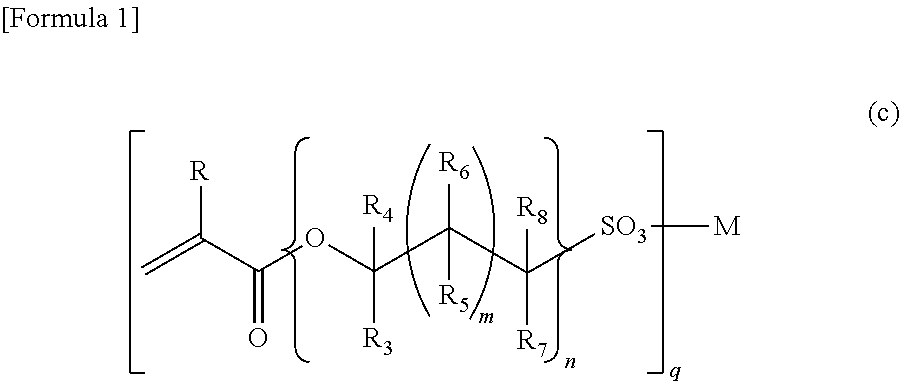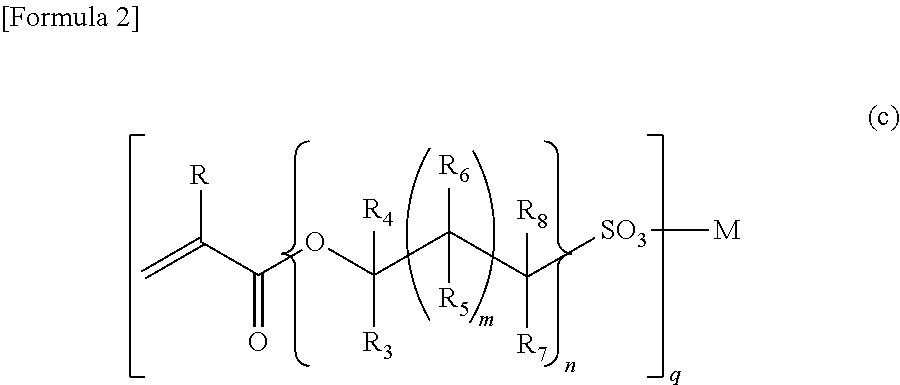Hydrophilic film
a technology of hydrophilicity and film, applied in the field of hydrophilic film, can solve the problems of low adhesion, low hardness, and reduced sharpness of anti-clouding properties, and achieve the effects of preventing clouding and pollution, excellent adhesion, and hydrophilicity
- Summary
- Abstract
- Description
- Claims
- Application Information
AI Technical Summary
Benefits of technology
Problems solved by technology
Method used
Image
Examples
example 1
[0205](Washing of Base Material)
[0206]A glass plate (surface water contact angle: 57 to)70° with a thickness of 2 mm was used as a base material and, first, was washed according to the following procedure.
[0207]Water was dropped on a surface of the glass plate 2 mm in thickness, and the glass plate (surface water contact angle: 57 to)70° was washed by rubbing with a cloth (Bemcot M-3, a production of Asahi Kasei Corp.) moistened with a suitable amount of a glass washing agent (High Shine HS-ordinary white: a product of Pionchemical Corp.). Subsequently, the abrasive was mostly washed away from the glass plate surface with water. Then, water was dropped on the surface of the glass plate, and the glass plate was washed by rubbing with another cloth (Bemcot M-3, a production of Asahi Kasei Corp.), and the abrasive was completely washed away from the glass plate surface with water. Lastly, the glass plate was dried using an air gun. The water contact angle of the glass plate after the w...
examples 2 to 7 and reference example 1
[0216]Films were formed on glass plates as in Example 1 except that the blending molar ratio of MPMOS / TMOS in the silane solution (1) was modified as shown in Table 2, and were subjected to the tests. The evaluation results of the films are shown in Table 2.
TABLE 2TABLE 2WaterWaterMPMOS / contactcontactTMOSSHangleangle(molarvalue1beforeGraftingafterAppear-Ad-AbrasionAbrasionGraftingratio)(meq / g)graftingcompoundgraftingancehesion*1**2***processExample 11 / 51.0446transparent100 / 100∘∘heatExample 21 / 31.5365↑↑↑∘x↑Example 31 / 41.2456↑↑↑∘∘↑Example 41 / 90.6446↑5↑↑∘∘↑Example 51 / 200.3134↑6↑↑∘∘↑Example 61 / 500.1327↑6↑↑∘∘↑Example 71 / 1000.0619↑6↑↑∘∘↑Reference1 / 12.8762↑↑↑xx↑Example 1*cross-cut test**steel wool #0000 × 0.1 kg × 10 cycles***steel wool #0000 × 2 kg × 10 cycles1the equivalent number of SH contained in 1 g of a mixture of component (a) and component (b)
reference examples 11 to 14
[0226]Films were formed on glass plates as in Comparative Example 2 except that TMOS was added to the silane solution (2) and that blending molar ratio of MPMOS / TMOS was modified, as shown in Table 4, in the formation of the hardened material layer, and were subjected to the tests. The evaluation results of the films are shown in Table 4.
TABLE 4TABLE 4WatercontactMPMOS / TMOSSHangle(molarvalue1GraftingafterAbrasionAbrasionGraftingratio)(meq / g)compoundgraftingAppearanceAdhesion*1**2***processComparative Example 21 / 05.0916transparent100 / 100xxUVReference Example 111 / 12.8726↑↑xx↑Reference Example 121 / 31.5334↑↑∘x↑Reference Example 131 / 51.0432↑↑∘∘↑Reference Example 141 / 90.6438↑↑∘∘↑*cross-cut test**steel wool #0000 × 0.1 kg × 10 cycles***steel wool #0000 × 2 kg × 10 cycles1SH value of silane solution before hardening
PUM
| Property | Measurement | Unit |
|---|---|---|
| temperature | aaaaa | aaaaa |
| temperature | aaaaa | aaaaa |
| temperature | aaaaa | aaaaa |
Abstract
Description
Claims
Application Information
 Login to View More
Login to View More - R&D
- Intellectual Property
- Life Sciences
- Materials
- Tech Scout
- Unparalleled Data Quality
- Higher Quality Content
- 60% Fewer Hallucinations
Browse by: Latest US Patents, China's latest patents, Technical Efficacy Thesaurus, Application Domain, Technology Topic, Popular Technical Reports.
© 2025 PatSnap. All rights reserved.Legal|Privacy policy|Modern Slavery Act Transparency Statement|Sitemap|About US| Contact US: help@patsnap.com



